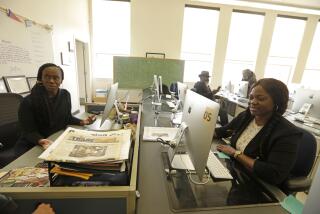Jill Carroll -- What an Inspiration Is
- Share via
BOSTON — For 82 days, a “FREE JILL” poster hung on the door of the journalism department at the University of Massachusetts at Amherst, Jill Carroll’s alma mater. On Friday, the words were changed to: “JILL IS FREE.”
Friends, family and colleagues of the 28-year-old freelance journalist, who was kidnapped in Iraq on Jan. 7, finally were able to share their joy the day after she was released.
Carroll arrived in Germany early today on a U.S. military flight from Iraq. She was scheduled to continue on to Boston.
“Uncountable have been the cumulative prayers and pleas, the messages of support and tears of concern shed for Jill Carroll over the past three months,” read a statement from the publishers of the Christian Science Monitor, the paper Carroll was reporting for in Baghdad. “Today, we cry tears of joy.”
The student newspaper Carroll worked for in the late 1990s devoted most of its Friday edition to her.
A Daily Collegian editorial lauded Carroll as an inspiration. A front-page article examined her journalism career, and a sports story recalled her prowess on the water polo team. A feature story focused on an artist who had used Carroll’s image in a mixed-media tribute. And the paper reprinted a column Carroll wrote in 1999, the year she graduated, titled “What a Woman Is.”
“They have developed such a connection to this young woman they never knew, who worked in the same space where they work now,” said Karen List, director of the school’s journalism program. “She really has become such a hero and a role model to them.”
List, 57, stayed in close contact with Carroll after she left Amherst to pursue a career as a foreign correspondent. A few days before Carroll was taken hostage while researching a story, List had talked to her about speaking on campus about her work in a war zone.
“I really admire the way she has tried to give voice to the Iraqi people, to report from the streets, to study the language, to report stories that otherwise might not have been reported,” List said.
Throughout her former student’s ordeal, List said, she traded e-mails and phone calls with Carroll’s family. Everyone close to the young woman fought to stay optimistic, List said, but they worried constantly nonetheless. During a protracted period without word from Carroll or her captors, who had threatened to kill her, it was difficult not to fear the worst, List said.
“We hadn’t heard anything about her for close to six weeks,” she said. “And of course the situation in Baghdad seems to have descended in that time into utter chaos. It was horrifying, having to go to bed each night not knowing if she was cold or hungry or hurt. I slept very well Thursday night.”
Late Friday, the Christian Science Monitor posted an article on its website stating that Carroll was forced by her captors to make a video criticizing President Bush and predicting that Iraqi insurgents would defeat American forces. The video surfaced Thursday and was denounced by conservative commentators.
Monitor Editor Richard Bergenheim said Friday that he was part of a group of staffers who focused “pretty much exclusively” on Carroll’s plight and on establishing contact with her captors.
“You can’t negotiate with those with whom you have no contact,” he said. “You can’t even pay them.”
In testament to the paper’s religious roots, Carroll’s colleagues sought spiritual solace.
“We really not only believe in prayer,” Bergenheim said. “We rely on it with all our hearts.”
The paper, he said, orchestrated “a very deliberate media campaign” on Carroll’s behalf in Baghdad. “Lots of people were concerned that there wasn’t lots of media activity generated over here,” he said. “But the activity was needed in Baghdad. It had to be in Arabic.”
On Friday, the paper’s website was flooded with expressions of support.
One family in Indiana said it did a dance around the breakfast table when it heard about Carroll’s release.
More to Read
Sign up for Essential California
The most important California stories and recommendations in your inbox every morning.
You may occasionally receive promotional content from the Los Angeles Times.












